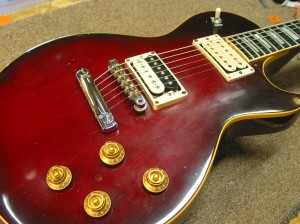Looking at purchasing an 04 Gibson Les Paul Standard Limited Edition off CL. It has a neck crack in the typical spot that was repaired by a local luthier/guitar builder and can barely be seen in the pics the seller has sent me. He's selling at what I feel is a very good price for a Gibson of. Look at this closeup of a 1950s Les Paul and you can see the binding nibs capping the ends of each fret. Here’s how to do that, using fret files. Gibson started shaping bindings at the fret ends nearly 100 years ago. After fretting the board, they slapped on the binding then scraped the heck out of. The newly designed Les Paul Recording guitar was released in 1971, in many ways as an updated version of the Les Paul Professional that had debuted two years earlier in 1969. The new guitar came with a new owners manual explaining the (somewhat complicated) controls, their operation, and giving other specifications, including recommended. Peg Head Binding: Logo: Mother of Pearl 'Gibson' Silkscreen: Gold 'Les Paul Model' Headstock Angle: 17 degrees: Tonal, Resonant, and/or Technical Effect: The rounded neck provides an ergonomic feel and the mahogany adds a rich tonal quality: Neck Fit: Joint Angle: 4 degrees: Joint Angle Tolerance: 0 deg 0 min 15 sec: Type: Mortise and Tenon. Play a guitar without binding and you can sometimes feel the fret edges. As stated in the previous post, the wood responds to the climate. My Tele neck was smooth until the seasons changed. They needed to be filed. From what I can tell the frets push on the binding. I haven't seen a gibson without the cracks.

XavierV
Senior Member

Hoping someone can give me advice.
My midnight tele fell about 2 feet and the binding cracked. It's on the back so I don't really care about cosmetics, all I want is to slap something on so the binding wont crack even worse.
Ordered this satellite glue and some tips.
Will this or should this work?
Also, should I smear this on and razor blade any extra glue?
Don't mind ugly, just trying to avoid 'a 3 year old could have done a nicer job'
Used Gibson Les Paul Standard
A very well written short history of the Gibson Les Paul can be found at Guitar Master Class. The first few paragaphs are provided here. Check out the link for the whole article!

'The Gibson Les Paul was first produced early in 1952, the Les Paul was the very first solid body guitar to be produced by the Gibson Company, and was created due to the fact that Leo Fender had proven the viability of such a product with the Fender Telecaster.

With Ted McCarthy at the helm, the Gibson Company wanted to make sure they acquired a share of the solid body market, and came up with the concept of approaching a well known musician, Les Paul, to design a range of solid body electric guitars. Interestingly, Les Paul had already approached Gibson in 1945 with some designs and ideas for an electric solid body guitar, and had been ridiculed by Gibson.
There is some ambiguity over just who designed which parts of the original Les Paul, with Les Paul himself telling a very different story to the Gibson employees at the time. In the Gibson version of the story, the company had already completed the design of the 1952 Les Paul before Les was approached to endorse it, the only modifications he made to the design were bridge and the name itself. The story told by Les himself is a little different, he tells that he already had the ideas for the Gold Top and the Black Custom, and Gibson gave him the final say in every part of the design process.

The original Les Paul design later came to be known as the Gold Top, due to the actual finish of the guitar. Most Les Paul guitars produced in this period came with a maple top that was gold coloured, with the back left natural. Hence gold on top, or Gold Top. The actual finish of the guitar was accomplished using a bronze powder, and over time, this took on a greenish due, resulting in the unmistakable vintage Gold Top look.
Used Gibson Les Paul Guitars
Gibson Les Paul Cracked Binding Tape
A matter of contention was the original Trapeze tailpiece, which was implemented incorrectly by Gibson according to Les Paul. Les had intended for the strings to wrap over the tailpiece, not under as the production models came out. This made playing using right hand dampening techniques virtually impossible. In 1953 Gibson finally decided that Les was right, and changed the tailpiece, as well as the angle that the neck joined the body. This resulted in a vastly improved playing experience. Although these changes worked to a degree, the design still had problems with intonation, and a year later the design was changed again to incorporate the tune-o-matic bridge we find on every Les Paul model, except those with a tremolo fitted, up to this day.'